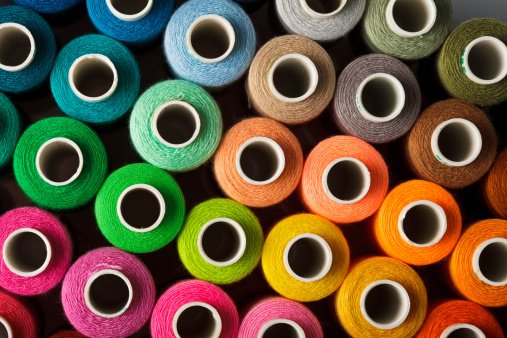Sewing Threads and Their Technical Applications For The Beginners
Due to the wide range of demands, sewing threads and their technical applications are receiving attention, especially the growing population of business men in the rural areas.
usage of various fiber types in the clothing industry, and rising use of textile materials in other industries including apparel and technical applications, a wide variety of sewing threads are now readily available on the market.
What is Sewing Thread?
According to ASTM, sewing thread is a flexible, small-diameter yarn or strand that is typically coated with a lubricant or both, and is designed to be used to sew one or more pieces of material together or an object to a material.
It can be characterized as a smooth, uniformly spun, hard-twisted ply yarn that has undergone a special finishing procedure to make it resistant to stresses in its passage through a needle’s eye and through materials used in seaming and stitching operations.
What are the Uses of Sewing Threads?
In order to unite several components by creating a seam, sewing threads are used in clothing, furniture, air-supported fabric constructions, and geotextiles.
The main purpose of a seam is to distribute stress uniformly from one piece of fabric to another, maintaining the integrity of the fabric assembly as a whole.
Common Materials used in Making Sewing Threads
Threads for high-temperature applications must be able to endure these conditions and keep the seams firmly in place at temperatures ranging from 260°C to 1100°C. Glass, graphite, polytetrafluoroethylene, steel, and aramid fibers are the most common materials used to make threads.
For low temperature applications such as car upholstery, the leather industry, and packaging like cement and fertilizer bags, polyesters, polypropylene, nylon 6, and nylon 66 are frequently used.
Medical sutures are specifically created and sterilized to meet the end uses for wound closure.
There are several methods for creating seams, including:
a). Mechanical: stitching and stapling.
b). Physical: heat-setting or welding.
c). Chemically: utilizing resins.
Due to the tendency of these techniques to change certain characteristics of the textile material, the production of seams by physical and chemical means is limited to a few specialized applications.
Sewing maintains its dominant position among mechanical sewing techniques thanks to its simplicity, sophisticated and cost-effective production methods, and the controllable elasticity of the seam produced.
Important Characteristics of Sewing Threads and Their Technical Applications
The threads used in the sewing process must meet specific, frequently quite strict requirements when using industrial sewing techniques.
Sewing threads is crucial since it significantly affects the quality of seams and manufacturing costs. The fabric to be sewn, the sewing method, and the intended use of the sewed material all have a significant impact on the sewing and seam performance of a sewing thread.
These conditions are described as follows:
i. The sewing thread’s capacity to successfully fulfill the functional demands of creating the required seam.
ii. The sewing thread’s capacity to give the seam the desired aesthetics and functionality.
iii. The price of thread for sewing and the price of creating the desired seam.
The following is a discussion of the various crucial characteristics that a sewing thread must possess:
1. Needle thread must be uniform, devoid of knots, non-torque, and flaws in order to freely pass through the needle’s tiny eye.
2. One of the fundamental characteristics of the thread is its tensile strength/breaking strength. During sewing, it must be able to tolerate numerous kinetic/lateral movements.
To prevent the thread from rupturing while being used, the sewing thread’s strength must be greater than that of the fabric.
The needle thread experiences repeated, extremely high-rate tensile stresses while stitching quickly. In addition, the thread is affected by heat, bending, pressure, torsion, and abrasion.
The magnitude of these strains is influenced by the sewing machine’s settings, thread, and stitching speed.
The pressures generated within the thread have a negative impact on its processing and functional properties, and after stitching, the thread’s strength is significantly reduced.
3. A moderate to low extension-at-break of the thread is typically desired for optimal performance in a sewing machine.
It has been observed that needle thread behaving somewhat differently during stitch production depends on its elongation-at-break.
The machine setting and unique characteristics of the sewing thread itself are the key factors in successfully sewing a thread with a specified elongation percentage without any issues.
4. For equal-length stitches to be made, the sewing thread’s elasticity must be consistent along its whole length, and it must precisely match the elasticity of the cloth being stitched; otherwise, during wear of the garment, either seam thread fracture or tearing of the neighboring fabric may occur.
It goes without saying that woven and knitted textiles will have distinct requirements.
Roles of Different Machines in the Production Process of Sewing Thread:
(a). Yarn Singeing
To prevent protruding strands from obstructing subsequent processing, sewing thread must be singed. By altering the yarn collection speed, a different percentage of singeing can be obtained.
The effectiveness of a hair removal machine typically ranges between 30% and 50%. The temperature of a flame is about 800°C. The majority of singeing is done with cotton sewing threads.
Features:
1. The burner, which is at the center of the device, burns the projecting yarn fibers reliably while they are moving through it at high speed without damaging the yarn itself.
2. The electric burner and the gas burner are available. The use of gas burner is common. Depending on the rate of burning and the type of yarn being used, the gas burner uses roughly 55 grams of natural, propane, or butane gas every hour.
(b). Winding From Hank to Cone
1. converting hank into a cone with the appropriate weight
2. Waxing to lower the friction coefficient in sewing thread.
The twin input rollers are located at the front of the head and are set at a preset speed that is proportional to the winding speed.
The main purposes of this apparatus are to remove unneeded tensions before the yarn enters the waxing apparatus.
A traverse of between 150 and 200 mm is attainable at a machine speed of 400 to 700 rpm.
(c). Polishing
In this machine, some threads are treated with starch, softeners, whiteners, etc. for unique end applications like as kite flying, bag stitching, and the leather industry. Depending on the intended purposes, cooked starch is combined with different chemicals and produced using various formulas for varying quality.
The primary goals of polishing are:
1. An exceptionally smooth surface
2. The thread turns round
3. Stiffness heightens
4. A 7–10% increase in tensile strength.
(d). Oiling and Cross-Winding
i. Winding several kinds of sewing thread bundles, such as cone, cop, tube, ball, and vicone, into the machine.
ii. To ensure the best workability during sewing operations, threads are coated with specific waxes.
iii. Parafin wax is the main component of the majority of the lick roller lubricants, which are used on industrial sewing thread that must operate on high-speed sewing machines.
Although different additives are often added to give some particular features, silicones are also employed because of their durability to heat.
Conclusion
Sewing thread and and their technical applications are a crucial element in the overall benefit of an entrepreneur.
With the right knowledge and information within his disposal, the textile industry can be a huge opportunity for him.
Polyesters, polypropylene, Nylon6, Nylon66, as well as bonding and lubricating agents, are frequently used to make sewing threads, which are used in the packaging, leather, and automotive industries.
Medical sutures often consist of synthetic yarns and have a very good promise. Moreover, new suture threads are being created to better meet specific surgical requirements.


